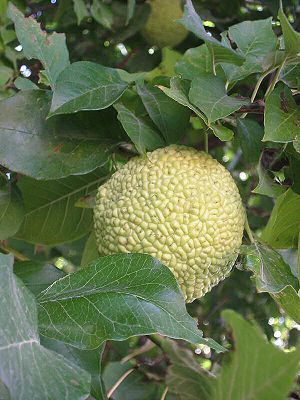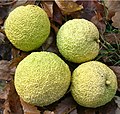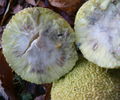Milk orange tree
| Milk orange tree | ||||||||||||
|---|---|---|---|---|---|---|---|---|---|---|---|---|

Milky orange tree ( Maclura pomifera ) |
||||||||||||
| Systematics | ||||||||||||
|
||||||||||||
| Scientific name | ||||||||||||
| Maclura pomifera | ||||||||||||
| ( Raf. ) CC cutting. |
The milk orange tree ( Maclura pomifera ), also called Osagedorn , is a species of Maclura in the family of the mulberry family (Moraceae).
description
Appearance and leaf
Maclura pomifera grows as a deciduous tree and reaches stature heights of up to 15 meters and crown diameters of up to 12 meters. The bark is dark brown and cracked. The thorn-reinforced branches form an open and irregular treetop .
The leaves are oval and dark green.
Inflorescence and flower
Maclura pomifera is dioecious separately sexed ( dioecious ), so the female and male flowers are formed on different individuals. The flowering period begins shortly after the foliage has formed and lasts from April to June. The male inflorescences are located on long inflorescence shafts on the uppermost leaf scar of the previous year , which are racemose and 2.5 to 3.8 centimeters long. The female inflorescences are formed in the leaf axils of the leaves. The female flowers are densely arranged in heady inflorescences that have a diameter of about 2.5 centimeters. The unisexual, greenish to yellow flowers are four-fold.
Infructescence and fruit
The milk orange tree begins to bear fruit between the ages of 12 and 15. Wrinkled and light green fruit associations are formed, which are composed of single-seeded stone fruits ; it is therefore a stone fruit association . These stone fruit associations are orange-like, initially green and spherical. The ripe fruit dressings can reach the size of a smaller melon with a diameter of 7 to 15 centimeters . The fleshy fruits are green initially, but turn yellow-green when they ripen between September and October. The fruits then smell faintly of oranges. Sometimes the ripe fruits weigh over 1 kg. They contain a bitter milky juice that turns the fruit black when dried.
Chromosome number
The number of chromosomes is 2n = 56.
Synecology
The pollination is carried by the wind.
The fruits are only broken open by gray squirrels to get to the seeds. Few other animal species native to North America use the fruit as food. This is unusual because plants usually produce fruit containing pulp because they use digestive expansion ( endochory ) as a propagation strategy . In the case of the milk orange tree, it is therefore assumed that the fruit was eaten by the prairie mammoth , mastodons and giant sloths. However, this American megafauna died out at the end of the last glacial period . In Central Europe, the fruits practically never ripen.
distribution
Maclura pomifera is native to the southern United States . The natural range is relatively small; it extends from southwest Arkansas and southeast Oklahoma to the eastern border of Texas .
Use and history
In 1804 Meriwether Lewis sent cuttings to Thomas Jefferson . Since then, the milk orange tree has been planted across the United States.
The milk orange tree is introduced and widespread in Central Europe near Scansano (Tuscany, Italy) and in Croatia . It was planted as a fence or road fortification. Otherwise you can find it sporadically in Central Europe as a street and park tree.
The original range of the Osage thorn in the border area of Texas, Arkansas and Oklahoma was the settlement area of the indigenous Osage , after whom the tree was named. As a material for the production of bows , the indigenous people traded the wood beyond its natural range. Osagedorn is still very popular today (along with the yew tree ) in traditional bow making as one of the most powerful woods, but due to its irregular growth it is quite demanding to work with.
Osagedorn served as a "living fence post" for the cattle pastures of many farmers, as the prickly branches can form impenetrable hedges. This practice ended with the introduction of the barbed wire . The wood is still used today for posts and fence posts because the heartwood is pest-resistant and weatherproof.
Cultivated forms
- 'Inermis': A thornless cultivated form
Habit and leaves
Inflorescences
Fruit heads
swell
- Connie Barlow, Paul Martin: The Ghosts of Evolution: Nonsensical Fruit, Missing Partners, and Other Ecological Anachronisms. BasicBooks, New York 2000, ISBN 0-465-00551-9 .
- DJ Mabberley: The Plant Book. A Portable Dictionary of the Vascular Plants . Cambridge University Press , 1991, ISBN 0-521-41421-0 .
- USDA Forest Service : Silvics of Trees of North America : Maclura pomifera - Datasheet.
further reading
- Osage Oranges Take a Bough. In: Smithsonian. Volume 34, Issue 12, March 2004, p. 35. ABSTRACT: Offers a look at the role played by the expedition of Merriweather Lewis in the US on the discovery of Osage orange or Maclura pomifera in 1804. Goals of his expedition; Origin of the Osage orange obtained by Lewis; Popularity of the tree as a barrier. Text.
Individual evidence
- ↑ Maclura pomifera at Tropicos.org. In: IPCN Chromosome Reports . Missouri Botanical Garden, St. Louis
- ↑ The Bible of Traditional Bow Making: Volume 3 . Verlag Angelika Hörnig, 2005, ISBN 978-3-9808743-9-7 ( google.de [accessed on September 14, 2017]).
Web links
- Maclura pomifera (Rafinesque) Nuttall . (Short info english)













